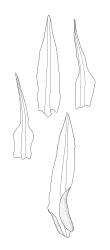Plants robust, forming dull, green or yellow-green turves. Stems erect or creeping, with brown, papillose rhizoids, in cross-section with a central strand and lacking thin-walled cortical cells. Leaves in 8 rows, of uniform length throughout or longer and crowded at stem apices, erect to somewhat reflexed from a sheathing base, with a distinct limb and base, linear-lanceolate, incurved when dry, channelled or tubular, not bordered, ± toothed, keeled; costa stout, strongly delimited, ending at the apex, often toothed above on abaxial surface, in cross-section mostly with 2 stereid bands. Laminal cells (of limb) unistratose, green, small, rounded-quadrate or rounded-hexagonal, mammillose adaxially, plane or mammillose abaxially; cells of the sheath lacking chlorophyll, pale or pigmented, mostly porose, sometimes papillose abaxially, elongate-rectangular to linear, narrower at margin.
Dioicous or autoicous. Perichaetial leaves little differentiated. Perigonia with filiform paraphyses. Setae terminal, elongate, single; capsules inclined, horizontal to pendent, oblong-ovoid from a short neck, brown, thick-walled, not or scarcely striate when moist, often furrowed when dry; stomata superficial, restricted to the neck and lower half of the urn; annulus well-developed, mostly revoluble; operculum hemispheric, usually ± apiculate. Peristome double, inserted far below the mouth and bound to it by a membrane; exostome teeth fused basally, broadly linear-lanceolate, abruptly reflexed in lower half when dry and the tips inflexed-horizontal, seldom perforate or split at apices, flat, in lower half yellow and punctate-cross-striate, in upper half whitish and coarsely vertically barred, with numerous lamellae; endostome free, ± as long as the teeth, yellow, with a high, keeled basal membrane dissected into 64 cilia that are often clustered in groups of 3–5 and fused at or near their apices and sometimes appendiculate adaxially. Calyptra cucullate, often clasping at its base and remaining attached to the upper seta at capsule maturity. Spores spherical, yellowish, almost smooth.
Timmia is a small genus largely restricted to higher latitudes in the northern hemisphere, with the exception of the N.Z. records of T. norvegica. The genus was interpreted to include four species and two infraspecific taxa by Brassard (1979, 1980, 1984).
According to Crum & Anderson (1981) the "leafy plants are relatively coarse and somewhat resemble a Polytrichum when moist because of leaves spreading from a sheathing base. Of course, the costa is narrow and has no lamellae on the upper surface; in addition the filamentous structure of the endostome is unique."
| Category | Number |
|---|---|
| Indigenous (Non-endemic) | 1 |
| Total | 1 |




